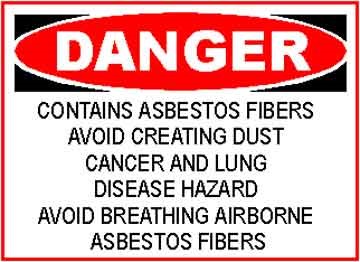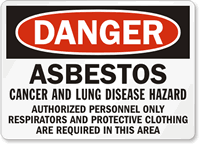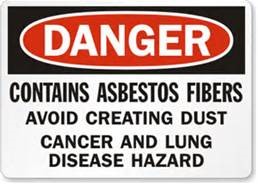2.1 Site Asbestos Control Plan
Each Microsoft location included in the scope of this program must develop a site-specific Asbestos Control Plan (“Site Plan”). The Site Plan must be made available to all affected employees and external staff, or any regulatory agency personnel. The Site Plan must include the following:
- Program purpose and scope.
- Site-specific regulatory requirements (State or Local).
- Personnel roles and responsibilities.
- A Plan Administrator must be designated for each facility to oversee implementation of the Site Plan.
- Definitions of terms critical to an understanding of the Site Plan.
- General safety rules for areas where asbestos is present.
- An inventory of all asbestos materials and their locations within the facility.
- A warning and notification system when asbestos is disturbed, or spills are found.
- A periodic, routine in-house monitoring or inspection system for identified asbestos materials
- Required elements for asbestos work plans related to the disturbance or removal of asbestos-containing (ACM) or presumed-asbestos containing materials (PACM).
- A description of workplace controls including engineering, administrative controls, and PPE requirements.
- Proper disposal methods for asbestos-containing waste materials.
- Incident investigations for all accidents, incidents, and near-misses that were directly or indirectly related to asbestos.
- Required training
- Incident investigations for all accidents, incidents, and near-miss incidents that were directly or indirectly related to the disturbance of asbestos.
- A thorough documentation and recordkeeping system.
2.2 Health Affects
In its non-friable (undamaged) state, asbestos poses no immediate health hazard. Asbestos becomes hazardous in its friable (crumbly or pulverized) state when it is disturbed, and microscopic fibers become airborne. Asbestos fibers remain suspended in air for long periods of time and can enter the lungs when inhaled.
Exposure to asbestos can cause asbestosis (scarring of the lungs resulting in loss of lung function that often progresses to disability and to death); mesothelioma (cancer affecting the membranes lining the lungs and abdomen); lung cancer; and cancers of the esophagus, and digestive system.
Asbestos may be found in pipe and boiler insulation, sprayed on fireproofing, troweled on acoustical plaster, floor tile and mastic, floor linoleum, transited shingles, roofing materials, wall and ceiling plaster, ceiling tiles, and gasket materials.
2.3 Permissible Exposure Limit
The OSHA permissible exposure limit (PEL) of 0.1 fibers per cubic centimeter of air as averaged over an eight-hour time weighted average and the excursion limit (EL) of 1.0 fibers per cubic centimeter of air as averaged over a 30-minute sampling period. Work practices, engineering controls, and personal protective equipment will be utilized to maintain asbestos airborne concentrations below the PEL and EL.
2.4 Asbestos Inventory
Real Estate and Facilities (RE&F) will ensure that the Site or Facility develops and maintains a current inventory of all potential building materials or components that contain asbestos. All facilities constructed prior to 1981 are presumed to contain ACM until a documented Risk Assessment has been completed.
Each area where ACM is suspected or known will be identified by name and location, the type of ACM, the quantity and condition, and data regarding any sample analysis of the material. This inventory of ACM will be maintained by RE&F and provided to Microsoft OHS, the Site Safety Administrator, or regulatory agencies upon request. See Appendix B for a sample Asbestos Inventory Form used for documentation.
Any areas that are not accessible in the surveyed building are presumed to contain asbestos materials and shall be included as such in the inventory. Precautionary exposure controls shall be implemented in the work area until the facility can verify whether ACMs are present.
Only qualified/licensed third-party service providers shall be retained to collect representative samples and analyze for the presence of asbestos. The survey is prioritized according to:
- Level of occupancy;
- Maintenance activity;
- Likelihood of disturbance; and,
- Human exposure potential.
Certified third-party service providers must be contracted to encapsulate or remove any friable asbestos. Microsoft employees or external staff are not authorized to collect asbestos samples or remove ACM.
Microsoft OHS or the Site Administrator can assist with recommendations of required engineering controls, administrative controls, work practices, and PPE related to a specific asbestos work plan.
2.5 Hazard Communication
All occupants of surveyed facilities containing known and/or suspected ACM, including Microsoft employees, external staff, contractors, and non-Microsoft tenants shall be notified in writing annually of the following:
- The location and physical condition of the ACM.
- Precautions to take when a spill or disturbance of the ACM is found.
- The need to avoid disturbing the material.
RE&F shall inform vendors or contractors who perform facility maintenance or housekeeping activities of the presence and location of ACM and/or PACM in such areas which may be disturbed.
Once previously installed ACM and/or PACM is identified, labels or signs shall be affixed or posted so that employees will be notified of materials containing ACM or PACM. The labels will be installed in locations where they are clearly visible. Signs may be posted in lieu of labels, as long as they contain the information required for labeling. The signage shall comply with all requirements and include the following information:

Labels shall also be affixed to all raw materials, mixtures, scrap, waste, debris, and other products containing asbestos fibers, or to their containers.

In addition, regulated areas in which asbestos removal is conducted and where respirators and protective clothing is required, must be properly barricaded with warning signs that include:

2.6 Periodic Visual Inspections
A visual inspection of all ACM shall be conducted at regular intervals as part of the Site Asbestos Control Plan and documented. The inspection process is intended to validate that the ACM has not become damaged or deteriorated. If the condition of the ACM materials has changed, appropriate response actions shall be immediately taken.
The visual inspections should be conducted at least annually by trained and authorized personnel. Photos or video of the area should be gathered and can be used to evaluate changes over time and the need for corrective actions. During the visual inspections, the current condition and physical characteristics are to be noted for determining the relative degree of damage and assessing the likelihood of future fiber release. See Appendix C for a sample Periodic Inspection Form used for documentation purposes.
Supplemental air monitoring by third party service providers may be used to detect airborne asbestos fibers in the building and can be used in conjunction with comprehensive visual and physical ACM inspections to assess the risk of exposure.
2.7 Hazard Controls for Work Involving Asbestos Removal or Disturbance
An Asbestos Work Plan will be developed for all tasks where ACM is removed or disturbed. A third-party contractor, qualified and licensed in asbestos remediation work, will be utilized to perform work that will or is likely to disturb ACM. Microsoft employees are not authorized to perform any type of asbestos work, including the clean-up of debris which may have fallen from insulating materials.
Asbestos Work Plans will define required hazard controls consistent with the OSHA’s classification of work as Class I, II, III, or IV. Work plans must be developed by qualified and certified Asbestos Work Planners. Work plans must also include waste disposal requirements consistent with the local or State regulations. As required in the EPA’s NESHAPs regulation, notification to EPA is required at least 10 days prior to any demolition or renovation projects involving more than 160 square feet or 260 linear feet of regulated ACM. Microsoft OHS is responsible to make notification to the EPA of any work activities that trigger the NESHAPs reporting threshold.
There are basic work practices that should be employed to minimize and/or contain asbestos fibers when there is the potential to disturb ACM. They include:
- Avoidance: When working around ACM, it is best to avoid certain activities that could disturb the material. Examples include: sawing, sanding and drilling. If portable power tools are used, they should be equipped with special local ventilation attachments.
- Wet Cleaning Techniques: Wet-wiping practices will pick up asbestos fibers, whereas dry methods will cause asbestos fibers to be suspended in the air. Once wet cloths, rags or mops are used to pick up asbestos fibers, they should be properly discarded as asbestos containing waste while still wet. Dry methods to pick up asbestos fibers are prohibited.
- HEPA Vacuums: The use of HEPA vacuums may be preferred to wet cleaning in certain situations. The vacuums will filter the asbestos fibers from the air passing through the vacuum. Caution should be used when emptying the HEPA vacuums and changing filters to prevent exposure. Workers should move the HEPA vacuum to a physically isolated area of the facility and put on proper PPE before emptying the dust and debris into properly labeled, sealed, and leak-tight containers for disposal as asbestos-containing waste.
- Steam Cleaning: If ACM has been released onto a carpeted area of a building, steam cleaning and HEPA vacuuming can be utilized. The APM should evaluate the need for respiratory protection. It is best for this type of cleaning to be done after normal working hours or when the facility is less occupied.
- Isolation for Major Fiber Release: In the event of major asbestos fiber releases, the area should be isolated by closing doors and/or erecting temporary barriers to restrict airflow as well as control access. Signs should be posted as necessary. If asbestos fibers could enter the HVAC system, the system should be modified to prevent fiber entry, or shut down and sealed off.
- Waste disposal: All asbestos containing wastes including discarded protective clothing are to be placed in plastic bags, sealed, labeled and disposed of at an approved waste disposal facility.
2.8 Personal Protective Equipment (PPE)
Personal Protective Equipment (PPE) is required when repair or removal tasks could expose asbestos workers to fiber levels above OSHA’s permissible exposure levels (PEL). Asbestos PEL is 1.0 fibers per cubic centimeter of air (1.0 f/cc), averaged over an eight-hour work shift.
Proper protective clothing used for asbestos work is disposable and consists of coveralls, head cover and foot covers made of a synthetic fabric which does not allow asbestos fibers to pass through. All clothing must be disposed of as asbestos-contaminated waste. Clothing must not be taken home. Microsoft’s Personal Protective Equipment Program defines the proper prescription and documentation associated with the use of PPE.
Some asbestos tasks may require the use of respirators. Single use, disposable paper dust makes do not provide adequate protection and are not allowed for asbestos work tasks. A half or full face, negative pressure, air-purifying respirator with replaceable high-efficiency filters or a powered air purifying respirator must be used. Microsoft’s defines the proper prescription and documentation associated with the use of respiratory protection in Microsoft’s Respiratory Protection Program.
Annual medical surveillance, fit testing, and training are required for anyone using a respirator. Asbestos workers are also subject to periodic medical surveillance. Microsoft’s Occupational Medical Surveillance Program defines the required assessments that must be performed by a physician or other licensed health care professional.
2.9 Training and Education
Asbestos training will be based on the type of work performed and the potential for exposure. All persons who may encounter asbestos-containing materials in the course of their work are required to complete annual Asbestos Awareness Training. Staff who generally need this training include Facilities Management staff, Janitorial/Housekeeping staff, Telecom workers, and other contractors.
Specialized contractors assisting with asbestos surveys or asbestos abatement projects may have potential exposures to fiber levels (either measured or anticipated) at or above the permissible exposure limit (0.1 fibers per cubic centimeter (f/cc)) as an 8-hour, time-weighted average (TWA) and/or the excursion limit (1.0 f/cc as a 30-minute TWA) shall receive further training as required by OSHA. As such, they require in-depth Asbestos Worker training which consists of an initial training and annual refresher training. Asbestos Training will cover:
- The properties of asbestos and its effects on health, including its interaction with smoking,
- The Asbestos Inventory and locations of ACM and suspected ACM in the building/facility.
- Asbestos signs and labels,
- Instruction in recognition of damage, deterioration, and delamination of building ACM,
- The operations that could result in asbestos exposure and the importance of preventive controls to minimize exposure,
- Safe work practices, control measures, and PPE,
- Emergency procedures,
- Hygiene requirements,
- Decontamination procedures,
- Waste handling procedures,
- Medical examination requirements, and
- An overview of the facility’s Asbestos Control Plan
Training requirements may vary by State and should be included in the Site Asbestos Control Plan.
2.10 Incident Investigation
The failure of hazard controls for asbestos resulting in a known or suspected exposure must be reported to Microsoft OHS and Benefits via submittal of the Incident Report Form. Upon receipt of the Incident Report Form, Microsoft OHS will review the case and determine the next steps in the investigation of the incident.
If the case involves a fatality or hospitalization, Microsoft OHS will inform CELA of the need to inform OSHA or the applicable State agency. Microsoft OHS will make the notification of the case to OSHA or the State agency. Microsoft OHS and CELA will be contacted whenever OSHA or a State agency conducts on-site inspections or inquiries involving incidents or reputed employee safety concerns.
Once the investigation of the incident is complete, communication of the results of the investigation will be shared with those groups with similar hazards or risks.


